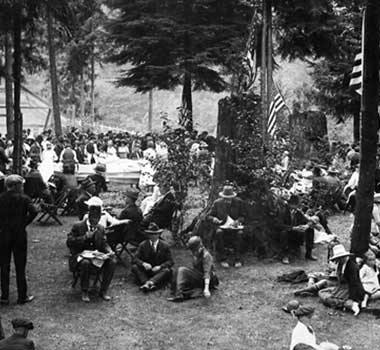There was a purpose for Carnation Farms. Elbridge Amos Stuart came to the grim realization that there were not enough cows in the world to produce the volume of milk he thought he needed for his fledgling Pacific Coast Condensed Milk Company (Carnation Milk).
Carnation Farms was created in 1908, when founder E.A. Stuart purchased the original 360 acres of farmland—sight unseen because of a tip from his childhood friend, Sam Hill, that the railroad would soon connect to this part of the world. In purchasing this farm his first priority was to increase the productivity of dairy herds. Another task was to get the milk to one of his milk plants in Monroe though his friend Sam would solve this problem for him in 1911. Stuart’s ideas fundamentally changed milk production, starting with the cows themselves.
To increase milk production, he embarked on a selective breeding program of Holstein cows which would dramatically increase the volume of milk that his cows produced on the farm and eventually around the world. Stuart was increasingly paying attention to the bloodlines of his animals and instituted a policy that would ensure the cows were happy as well as healthy. Carnation Farms built their dairy operations around the concept of well-treated cows. EA fostered the idea that cows which avoided stress and mistreatment would be able to produce more milk. In a 1906 marketing meeting in Chicago, he described the treatment of the cows, how they were fed and the farm that they lived on. A lady from the marketing firm absent-mindedly commented that “they must be very contented cows”. This was the light bulb moment in which the tagline for the company was born.
In the breezeway of the main barn, where many of the milking cows were housed, there remains to this day a sign which lays out guidelines for how to treat the cows:
“The RULE to be observed in this stable at all times, toward the cattle, young and old, is that of patience and kindness….
Remember that this is the home of mothers. Treat each cow as a mother should be treated. The giving of milk is a function of motherhood; rough treatment lessens the flow. That injures me as well as the cow. Always keep these ideas in mind in dealing with my cattle.”
In fact, there was also no bad language allowed around the Carnation herd, both at home and when the cows would occasionally travel for exhibitions. In some of the early photographs of the barns, one can see signs that say “no swearing”.
Another way to encourage milk production and contented cows was to ensure that the best milk cows were paired with the best workers. This proved to be a winning combination in 1921 with a cow named Segis Pietertje Prospect, lovingly known as “Possum Sweetheart”, and a milker named Carl Gockerell. In 1900, the average milk production for a cow was 1,500 -1,900 pounds of milk per year. The combination of “Possum Sweetheart” and Gockerell resulted in a record-shattering 37,000 pounds of milk produced in one year. When “Possum Sweetheart” died, both Stuart and Gockerell were so deeply grieved that they constructed the world’s earliest known statue to a Holstein cow. The cow statue still remains on display at the farm today.
It wasn’t just a few superior cows that increased the fame and fortune of Carnation Farms. The foundation herds cultivated by Carnation became breeding stock the world over. The farm eventually moved, from milk production to breeding and then into genetics research. The results and their cows remained famous throughout the world for holding the world milk production record for 36 consecutive years. The legacy of Carnation cows can still be seen in dairy herd bloodlines to this day.
In 1929, Carnation acquired the Albers Milling Company which allowed the company to enter the cereals and animal feeds market. Palatability and nutritional research were expanded at the farm to a larger variety of animals. The largest and most profitable group were dogs and later cats. The research here opened a variety of consumer products including the Friskies brand.
Since its founding in 1908, Carnation Farms has gone through a few transitions. The Stuart family sold the company and the farm to Nestle in January of 1985. Nestle ran the farm until 2008 when a non-profit bought it. The family repurchased the farm in 2010. October of 2016 began a new start for the historic farm when Elbridge Stuart III, Debra Stuart, Sarah Stuart Oderyd, and Daniel Oderyd, inspired by E.A. Stuart’s philanthropic legacy, founded a new non-profit called Carnation Farms. The new mission aims to go back to the farm’s roots. They intend to share the 818-acre organic farm with the community. The mission is to be a community-based hub for regenerative food and agriculture that educates and empowers the work of culinary, food, and farming professionals. And by doing so, we will help create a thriving regional food system connecting farmers and culinary professionals around shared values of regenerative food, health and equity.
Since this landmark farm has been in production since 1908, the organization has gathered an incredible collection of historical documents, artifacts, even vehicles. History and Museums at Carnation Farms will conduct historical tours, build and maintain the museums on-site, and develop historical programming.
Contact history@carnationfarms.org for more information.
